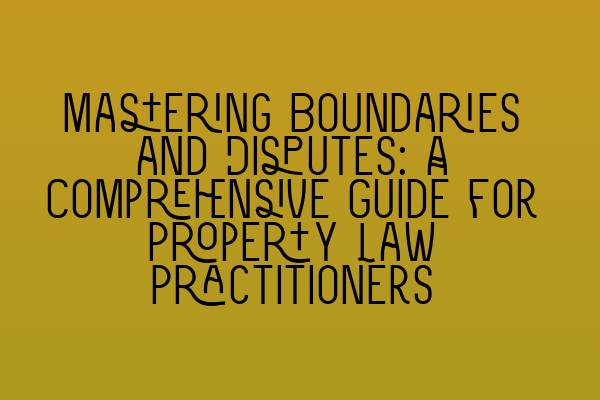Mastering Boundaries and Disputes: A Comprehensive Guide for Property Law Practitioners
As property law practitioners, understanding and mastering boundaries and disputes is essential. The intricacies and complexities of property boundaries can often lead to disputes between parties, making it crucial for practitioners to have a comprehensive understanding of the relevant laws and regulations. In this guide, we will explore key concepts and provide practical insights to help you navigate through boundary issues with expertise and confidence.
Understanding Property Boundaries
Property boundaries define the extent of ownership and control over land. They play a vital role in determining a property owner’s rights and responsibilities. However, establishing and demarcating boundaries is not always straightforward. It requires a meticulous evaluation of various factors, such as title deeds, land surveys, fences, walls, hedges, and historical evidence. Being well-versed in the legal principles and regulations surrounding boundary determinations is crucial in handling disputes effectively.
When it comes to determining property boundaries, there are two main legal concepts to consider: adverse possession and easements.
Adverse Possession
Adverse possession refers to the acquisition of property rights through continuous and uninterrupted possession of another person’s land for a specified period. This legal doctrine enables someone who has occupied a piece of land without permission to claim ownership. Understanding the requirements and elements of adverse possession is crucial in advising clients and resolving disputes related to boundary encroachments.
Easements
Easements grant specific rights over another person’s land. These rights may include access to a property, the right to use a particular piece of land, or the right to receive certain services. Easements can be created through legal agreements or by long-standing use. As a property law practitioner, you must be well-versed in identifying, interpreting, and negotiating easements to assist clients in boundary-related disputes.
Resolving Boundary Disputes
Boundary disputes can arise due to various reasons, such as conflicting title deeds, ambiguously defined boundaries, nuisance issues, or the encroachment of structures onto neighboring properties. When faced with boundary disputes, it is crucial to follow a systematic approach to resolve them effectively.
1. Investigation and Gathering Evidence
The first step in resolving a boundary dispute is to conduct a thorough investigation. Gathering evidence such as title deeds, land surveys, and historical documents is essential in understanding the historical context and establishing the accurate boundary. It is crucial to examine any physical features on the ground, such as fences, walls, or hedges, that may contribute to boundary identification.
2. Negotiation and Mediation
Once the evidence has been collected, it is advisable to attempt negotiation and mediation before pursuing litigation. Engaging in open and constructive communication with the opposing party may lead to amicable resolutions. Mediation can be a valuable tool in facilitating discussions and helping parties reach mutually agreeable solutions.
3. Court Proceedings
If negotiation and mediation fail to yield satisfactory results, court proceedings may become necessary. Property law practitioners must be proficient in preparing legal arguments, presenting evidence, and navigating through the court system to represent their clients effectively.
Best Practices for Property Law Practitioners
Here are some best practices to keep in mind as a property law practitioner when dealing with boundaries and disputes:
1. Thorough Research and Due Diligence
Always conduct meticulous research and due diligence to ensure you have a complete understanding of the relevant laws, regulations, and precedents. This will enable you to provide accurate advice and represent your clients effectively.
2. Clear and Timely Communication
Maintain clear and timely communication with your clients throughout the process. Explain complex legal concepts in simple terms and keep them updated on the progress of their case. Effective communication builds trust and ensures client satisfaction.
3. Collaboration with Experts
Collaborate with experts such as land surveyors, architects, or historians to gather additional evidence and support your case. Their specialized knowledge and expertise can provide valuable insights and strengthen your arguments.
4. Continuous Professional Development
Stay up-to-date with the latest developments in property law by engaging in continuous professional development. Attend workshops, seminars, and webinars to enhance your knowledge and skills, ensuring you are delivering the best possible service to your clients.
Mastering boundaries and disputes is a fundamental aspect of property law practice. By understanding the legal principles, conducting thorough investigations, employing effective negotiation techniques, and staying up-to-date with industry developments, property law practitioners can navigate through complex boundary issues with confidence and competence.
Whether you are dealing with adverse possession claims, resolving easement disputes, or addressing encroachments, having a comprehensive understanding of property boundaries is crucial for successfully representing your clients.
If you are interested in learning more about property law, preparing for your SQE exams, or staying updated on important exam dates, visit our related articles:
- SQE 1 Practice Exam Questions
- SQE 1 Practice Mocks FLK1 FLK2
- SQE 2 Preparation Courses
- SQE 1 Preparation Courses
- SRA SQE Exam Dates
By accessing these resources, you can further enhance your knowledge and skills to excel in your property law practice.
